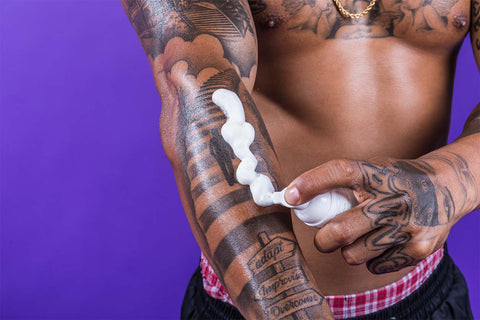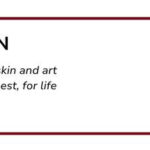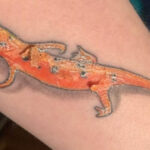Getting a tattoo is a deeply personal experience, and at tattooat.com, we understand that you’re curious about what it actually feels like. From the initial sting to the final masterpiece, the sensation varies, influenced by placement, pain tolerance, and even the artist’s technique, but we will provide you with insights that will help you prepare for your first tattoo, understand the different pain levels, and discover aftercare tips for tattoo healing. Whether you’re a tattoo virgin or adding to your collection, understanding these nuances will empower you to make informed decisions and embark on your tattoo journey with confidence. Explore our rich library of tattoo designs, find talented artists, and learn essential aftercare practices at tattooat.com. We will provide you with valuable resources and tips to make your tattoo experience as smooth and enjoyable as possible, also ensuring your tattoo remains vibrant and beautiful for years to come.
1. What Factors Influence the Feeling of Getting a Tattoo?
Several factors determine the tattoo experience, but the common sensation is “vibrating pins.” Some of these factors include the specific location on the body being tattooed, the individual’s pain tolerance, the size and complexity of the design, the tattooing technique used by the artist, and the mental and emotional state of the person receiving the tattoo.
- Location, Location, Location: Areas with more nerve endings or thinner skin tend to be more sensitive.
- Pain Tolerance: Everyone experiences pain differently; what’s intense for one person might be a mild tingle for another.
- Design Complexity: Larger, more intricate tattoos that require longer sessions can increase discomfort.
- Artist Technique: An experienced artist with a steady hand can make the process smoother and potentially less painful.
- Mental State: Being relaxed and prepared can significantly impact your perception of pain.
2. What Do Different People Say About Tattoo Pain?
Experiences vary widely, ranging from “a continuous bee sting” to “painfully exciting.” Many people describe it as a stinging, burning, or scratching sensation.
Anecdotal Insights:
- The Bee Sting: One person likened it to a continuous bee sting, emphasizing that while bearable, it’s still painful, especially in sensitive areas like the hand and wrist.
- Bone Marrow Biopsy vs. Flu Shot: Another person described the pain as somewhere between a bone marrow biopsy and a flu shot, noting that the after-effects, like prickling and burning, can be more intense.
- The Scratching Sunburn: Some describe the sensation as similar to scratching a sunburn, which can be irritating but manageable.
- Tiny Electric Shocks: Others experience it as a series of tiny electric shocks, which can be surprising but not necessarily unbearable.
- Hot Sandpaper Exfoliation: For one person, the process felt like their skin was being exfoliated off with hot sandpaper, particularly during the filling in of black ink.
3. Which Tattoo Placements Are Known To Be More Painful?
Areas with thinner skin, less fat, or more nerve endings tend to be more sensitive.
Areas That Often Cause More Discomfort:
| Body Part | Why It Hurts More |
|---|---|
| Ribs | Skin is thin and close to the bone |
| Head and Face | Numerous nerve endings |
| Inner Thigh | Sensitive skin |
| Armpit | Sensitive skin and nerve endings |
| Hands and Feet | Bones close to the surface; many nerves |
| Sternum (Chest) | Bone close to the surface |
| Stomach | Sensitive skin; potential for stretching |
| Elbows and Knees | Bone close to the surface; stretching |
4. How Can I Mentally and Physically Prepare for a Tattoo?
Preparation can significantly impact your experience. Eat well, stay hydrated, avoid alcohol and caffeine, and get enough sleep. Mentally, try to relax and focus on the end result.
Essential Tips for Preparation:
- Eat a Good Meal: Ensure your blood sugar is stable to prevent lightheadedness.
- Stay Hydrated: Hydrated skin is easier to work with.
- Avoid Alcohol and Caffeine: These can thin your blood and increase sensitivity.
- Get Enough Sleep: Being well-rested helps you manage pain better.
- Relax: Listen to music, meditate, or use other relaxation techniques to calm your nerves.
- Numbing Agents: If concerned about pain, consider using a topical numbing cream or gel, like those available at tattooat.com.
5. What Are Some Effective Ways To Manage Pain During A Tattoo Session?
Use numbing creams or gels, take breaks, listen to music or podcasts, and communicate with your artist. Distraction can be a powerful tool.
Strategies for Pain Management:
- Numbing Products: Topical anesthetics can significantly reduce pain.
- Take Breaks: Don’t hesitate to ask for a break if you need one.
- Distraction: Listen to music, podcasts, or audiobooks to keep your mind occupied.
- Communicate: Let your artist know if you’re in too much pain; they can adjust their technique or take a break.
- Breathing Exercises: Deep, controlled breathing can help you relax and manage pain.
6. What Does Tattoo Aftercare Involve, and Why Is It Important?
Proper aftercare is crucial for healing and preventing infection. Keep the area clean and moisturized, avoid direct sunlight, and follow your artist’s instructions.
Key Steps for Tattoo Aftercare:
- Keep It Clean: Gently wash the tattoo with mild soap and water.
- Moisturize: Apply a thin layer of tattoo-specific lotion or ointment.
- Avoid Sunlight: Protect your tattoo from direct sunlight to prevent fading.
- Don’t Pick or Scratch: Let the tattoo heal naturally; avoid picking at scabs.
- Follow Artist’s Instructions: Each artist may have specific recommendations for aftercare.
- Use Soothing Ointments: If you have sensitive skin or eczema, use a soothing ointment to relieve itching.
 New Tattoo Aftercare
New Tattoo Aftercare
7. How Do Machine Tattoos and Stick-and-Poke Tattoos Differ in Terms of Sensation?
Machine tattoos generally provide a more consistent sensation, while stick-and-poke tattoos can feel like individual pinches.
Machine Tattoos:
- Consistent Sensation: The electric machine delivers a steady, vibrating sensation.
- Faster Process: Typically quicker than stick-and-poke, reducing overall discomfort.
Stick-and-Poke Tattoos:
- Individual Pinches: Each poke is felt individually, which can be more intense.
- Slower Process: Takes longer, which can lead to increased sensitivity over time.
8. Can Numbing Creams and Gels Really Help Reduce Tattoo Pain?
Yes, numbing creams and gels can significantly reduce pain by temporarily blocking nerve signals in the area being tattooed.
Benefits of Numbing Agents:
- Reduced Pain: Topical anesthetics like lidocaine can numb the skin.
- More Comfortable Sessions: Allows for longer sessions with less discomfort.
- Improved Experience: Can make the overall tattoo experience more enjoyable, especially for those with low pain tolerance.
- Recommended Products: tattooat.com offers a variety of numbing gels and creams designed to minimize pain during tattooing.
9. What Are The Latest Trends and Techniques in Tattooing in the USA?
Fine-line tattoos, geometric designs, and watercolor styles are popular. Techniques like micro-realism and blackwork are also gaining traction.
Current Trends in American Tattoo Culture:
| Trend | Description |
|---|---|
| Fine-Line Tattoos | Delicate, minimalist designs with thin lines |
| Geometric Designs | Intricate patterns and shapes, often incorporating sacred geometry |
| Watercolor Styles | Soft, blended colors that mimic watercolor paintings |
| Micro-Realism | Highly detailed, miniature portraits and scenes |
| Blackwork | Bold, graphic designs using only black ink |
| Neo-Traditional | Revamped traditional designs with brighter colors and bolder outlines |
| Illustrative Tattoos | Tattoos that resemble illustrations, often with a story-telling aspect |
10. How Can I Find Reputable Tattoo Artists and Studios in the USA?
Research online, read reviews, check portfolios, and visit studios to assess their cleanliness and professionalism. Word of mouth can also be valuable.
Tips for Finding the Best Artists and Studios:
- Online Research: Use websites like tattooat.com to find artists and studios near you.
- Read Reviews: Check Google, Yelp, and other review sites for feedback from previous clients.
- Check Portfolios: Review the artist’s portfolio to ensure their style matches your vision.
- Visit Studios: Assess the studio’s cleanliness, professionalism, and adherence to safety standards.
- Ask for Recommendations: Word of mouth can be a great way to find reputable artists.
- Consultations: Schedule consultations to discuss your design and assess the artist’s expertise.
11. How Does Skin Hydration Affect The Tattooing Experience?
Hydrated skin is more pliable and easier to work with, leading to a smoother and potentially less painful tattooing process.
Benefits of Hydrated Skin:
- Easier Application: Needles glide more smoothly over hydrated skin.
- Reduced Irritation: Well-hydrated skin is less prone to irritation and inflammation.
- Better Ink Absorption: Hydrated skin absorbs ink more effectively, resulting in a more vibrant and lasting tattoo.
- Faster Healing: Proper hydration supports the skin’s natural healing process.
12. What Role Does The Tattoo Machine Play in The Overall Sensation?
The type of machine, its settings, and the artist’s skill in using it all influence the sensation. Rotary machines tend to be smoother, while coil machines can feel more intense.
Understanding Tattoo Machines:
| Machine Type | Sensation | Characteristics |
|---|---|---|
| Rotary | Smoother, consistent | Uses a rotary motor for smooth, even strokes; often quieter than coil machines |
| Coil | More intense | Uses electromagnetic coils to move the needle; can be more powerful and vibrate more |
13. How Long Does The Pain Typically Last During A Tattoo Session?
The duration of pain varies depending on the tattoo’s size, complexity, and location. Some people experience pain throughout the session, while others find that it subsides after the initial outline.
Factors Affecting Pain Duration:
- Size and Complexity: Larger, more intricate tattoos take longer and can cause more sustained pain.
- Location: Sensitive areas will likely be more painful for a longer duration.
- Individual Tolerance: Your personal pain tolerance will influence how long the pain feels intense.
- Breaks: Taking regular breaks can help manage the pain and make the session more bearable.
14. Are There Any Medical Conditions That Could Affect My Tattoo Experience?
Yes, certain conditions like eczema, diabetes, and bleeding disorders can affect the tattooing process and healing. Consult with your doctor and tattoo artist before getting a tattoo if you have any medical concerns.
Medical Conditions To Consider:
- Eczema: Can cause increased itching and irritation during healing; use soothing, hypoallergenic products.
- Diabetes: May slow down the healing process and increase the risk of infection; ensure your blood sugar is well-managed.
- Bleeding Disorders: Can cause excessive bleeding during tattooing; consult with your doctor before proceeding.
- Allergies: Be aware of potential allergies to tattoo inks; ask for a patch test before getting a large tattoo.
15. How Does Shading Compare To Line Work In Terms Of Pain?
Shading often feels different from line work; some describe it as a scraping or burning sensation, while line work can feel sharper and more precise.
Different Sensations:
- Line Work: Often described as a sharp, precise sting; can be more intense initially.
- Shading: Can feel like a scraping or burning sensation as the artist fills in areas; may be less intense but more prolonged.
16. What Kind of Aftercare Products Are Best For My New Tattoo?
Choose fragrance-free, hypoallergenic lotions or ointments specifically designed for tattoo aftercare. Avoid products with harsh chemicals or alcohol.
Recommended Aftercare Products:
- Fragrance-Free Lotion: Keeps the tattoo moisturized without causing irritation.
- Hypoallergenic Ointment: Provides a protective barrier and promotes healing.
- Tattoo-Specific Balms: Often contain natural ingredients that soothe and nourish the skin.
- Soothing Ointments for Eczema: If you have eczema, use a gentle, eczema-friendly ointment to relieve itching and inflammation.
17. How Soon After Getting A Tattoo Can I Resume Normal Activities?
Avoid strenuous activities, swimming, and prolonged sun exposure for at least two weeks. Follow your artist’s specific recommendations for resuming normal activities.
Activities To Avoid:
- Strenuous Exercise: Can cause excessive sweating and irritation.
- Swimming: Pools and oceans can harbor bacteria that can cause infection.
- Sun Exposure: Can fade the tattoo and damage the skin.
- Tight Clothing: Can rub against the tattoo and cause irritation.
18. What Are Some Common Misconceptions About Tattoo Pain?
One common misconception is that all tattoos are excruciatingly painful. While it can be uncomfortable, many people find the pain manageable, and the experience is often “painfully exciting.”
Common Myths vs. Reality:
- Myth: All tattoos are extremely painful.
- Reality: Pain levels vary depending on location, individual tolerance, and other factors.
- Myth: Numbing creams don’t work.
- Reality: Many numbing creams are effective at reducing pain, especially when applied correctly.
- Myth: Tattoos always get infected.
- Reality: With proper aftercare, the risk of infection is low.
19. How Do Different Colors of Ink Affect The Tattooing Experience?
Some people find that certain colors, like red or yellow, can be slightly more irritating than others, but this varies from person to person.
Ink and Sensitivity:
- Red and Yellow: Some individuals report these colors can cause more irritation due to potential allergic reactions or the pigments used.
- Black: Generally well-tolerated, but can sometimes cause reactions in sensitive individuals.
- Quality of Ink: Higher-quality inks are less likely to cause irritation or allergic reactions.
20. What Is The Overall Psychological Impact of Getting A Tattoo?
For many, getting a tattoo is a transformative experience that can boost self-esteem and provide a sense of empowerment. It’s a way to express individuality and connect with one’s body and identity.
Psychological Benefits:
- Self-Expression: Tattoos allow you to express your personality and beliefs.
- Empowerment: Taking control of your body and making a permanent change can be empowering.
- Self-Esteem: Many people feel more confident and attractive with their tattoos.
- Connection: Tattoos can connect you to a community of like-minded individuals.
Navigating the world of tattoos can be exciting and transformative, and tattooat.com is here to guide you every step of the way. Whether you’re seeking inspiration for your next design, searching for a talented artist, or need advice on aftercare, our comprehensive resources are designed to enhance your tattoo journey.
Ready to dive deeper? Visit tattooat.com today to explore a wealth of designs, find top-rated artists, and learn everything you need to know about tattoo aftercare. Your perfect tattoo experience awaits.
Address: 1825 SW Broadway, Portland, OR 97201, United States.
Phone: +1 (503) 725-3000.
Website: tattooat.com.
FAQ: Your Questions About Tattoo Sensations Answered
1. What does getting a tattoo feel like on bony areas?
Getting a tattoo on bony areas like the ribs or ankles often feels more intense due to the lack of muscle and fat cushioning the bone.
2. How much does pain tolerance affect the tattoo experience?
Pain tolerance plays a huge role; people with higher pain tolerances often find the experience more manageable.
3. Can I use over-the-counter pain relievers before getting a tattoo?
It’s best to avoid blood-thinning medications like aspirin or ibuprofen before getting a tattoo, as they can increase bleeding.
4. How long does it take for a tattoo to heal completely?
A tattoo typically takes about 2-4 weeks to heal on the surface, but the skin may continue to heal beneath the surface for several months.
5. Is it normal for a tattoo to itch during the healing process?
Yes, itching is a normal part of the healing process. Avoid scratching the tattoo to prevent infection and damage.
6. What are the signs of a tattoo infection?
Signs of infection include excessive redness, swelling, pus, fever, and increased pain. If you suspect an infection, seek medical attention immediately.
7. Can I get a tattoo removed if I don’t like it?
Yes, laser tattoo removal is an option for removing unwanted tattoos, but it can be expensive and time-consuming.
8. How do I choose the right tattoo artist for my design?
Research artists, review their portfolios, and choose someone whose style matches your design vision.
9. Are there any long-term risks associated with getting a tattoo?
Long-term risks are minimal with proper aftercare and a reputable artist, but allergic reactions and scarring are possible.
10. How can I make my tattoo last longer?
Protect your tattoo from sunlight, keep it moisturized, and maintain a healthy lifestyle to help it stay vibrant for years to come.

